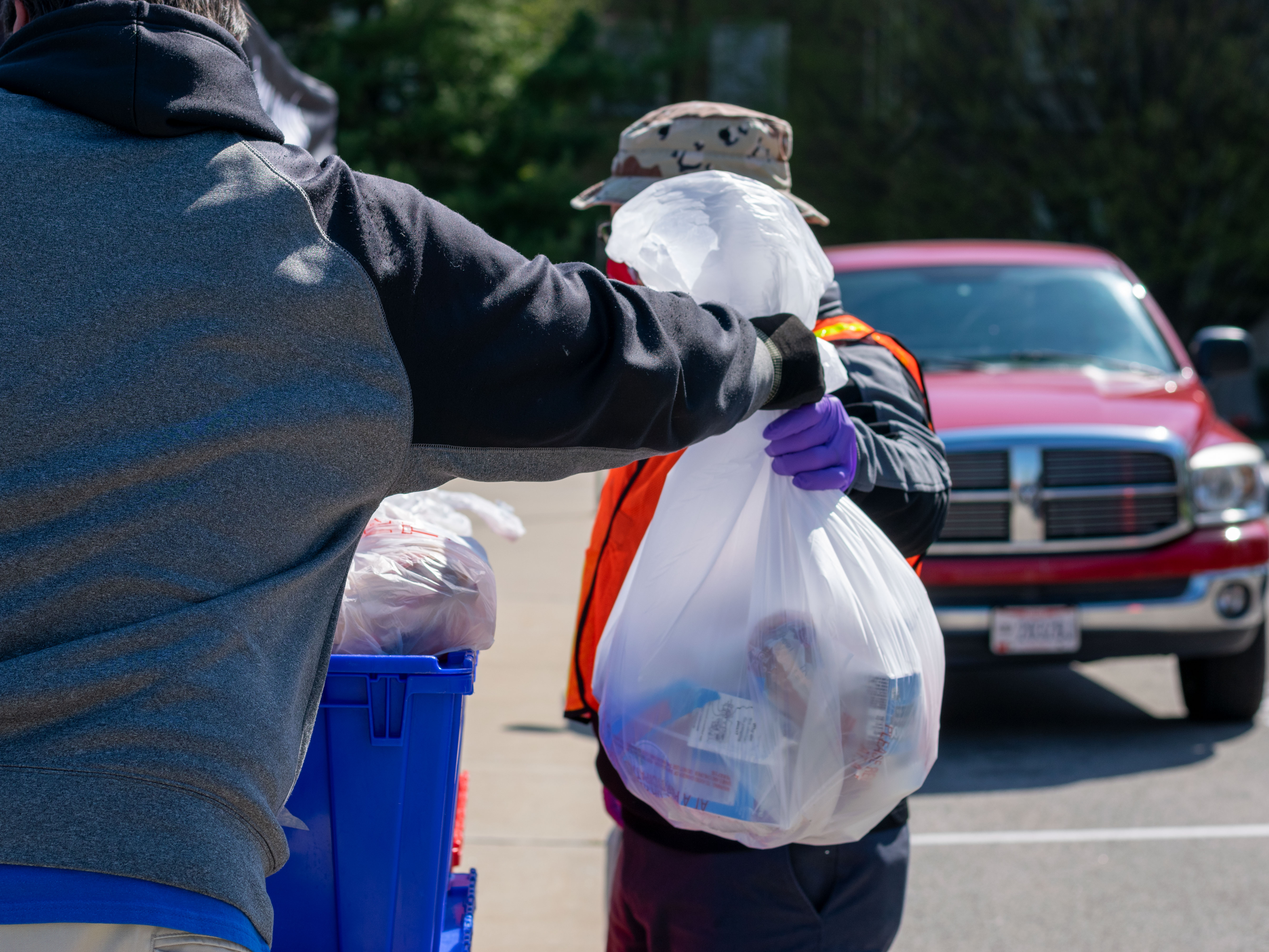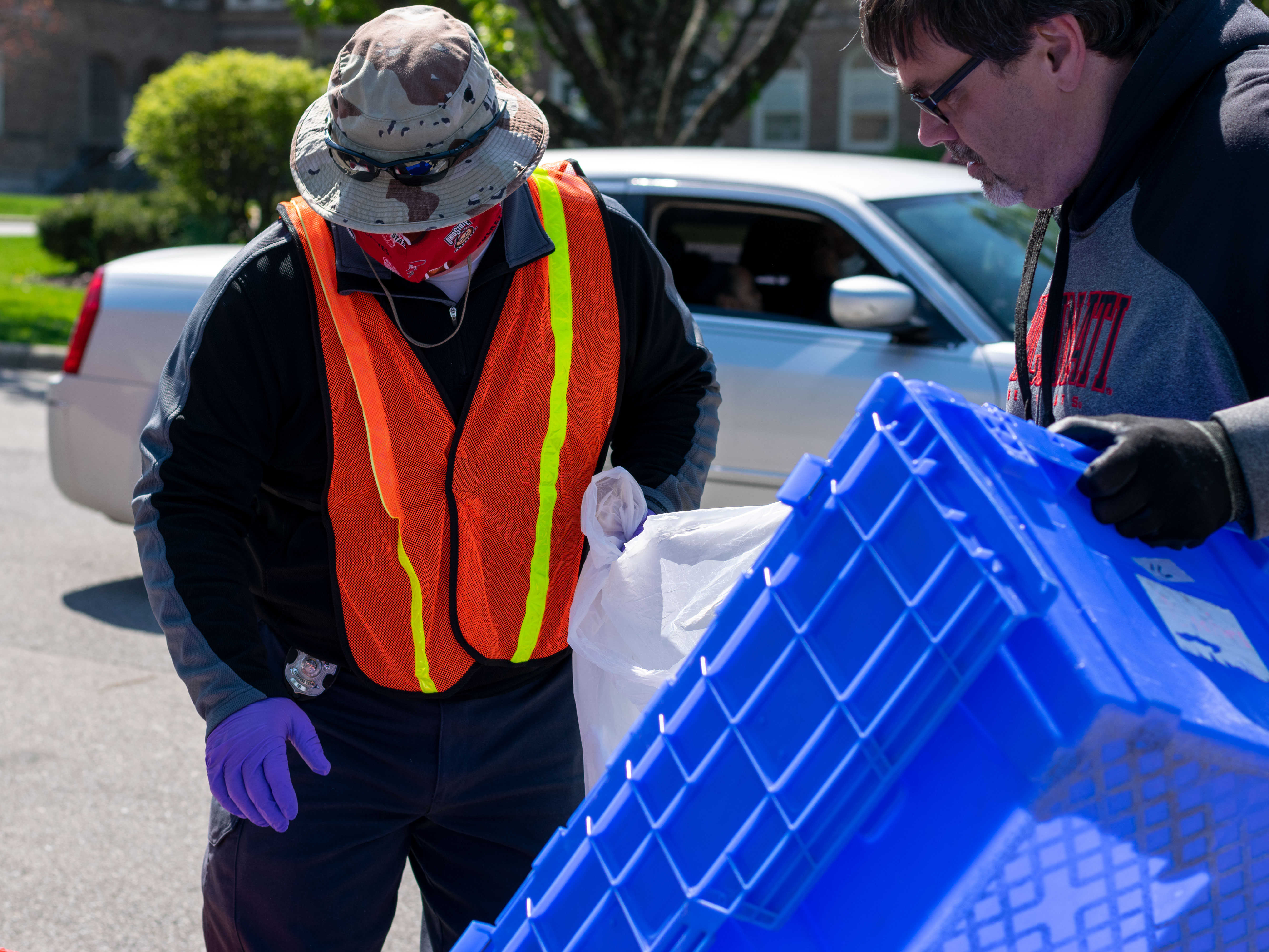
By Sara Ruberg
On the front driveway, a grey-haired woman and two men wearing masks and rubber gloves shove grocery bags full of PB&J sandwiches into larger plastic bags. Around 11 a.m., families start to show up to pick up their lunches. Most days at Western Hills High School in Cincinnati, meals for food insecure students go quickly — sometimes in less than 30 minutes.
When the bins of food begin to run out, someone has to drive to one of the other 23 meal distribution sites to grab more meals, or start redirecting parents to them. More than 83% of Cincinnati Public Schools (CPS) students rely on free or reduced-price meals during the school year, but the meal program was upended when the pandemic started.
“We are placing a meal distribution site within one mile of all of our CPS students with a focus on the areas of high poverty,” Jessica Shelly, the director of Student Dining Services at CPS, said. “We take care of our scholars whether they’re in school or out.”
Ohio schools shut down on March 16 to prevent students from getting and spreading coronavirus. Since then, school districts and restaurants around the Greater Cincinnati area have quickly found new ways to feed food-insecure students who relied on school meals.
Of all the sites CPS has set to continue to feed kids, Western Hills High School is one of the busiest. The sites are open Monday, Wednesday and Friday from 11 a.m. to 12 p.m., and workers distribute about 2,400 breakfasts and 2,400 lunches every day, along with K-12 academic packets for students without access to WiFi or technology.
School districts are preparing for more families to face food insecurity as layoffs increase. Many students were vulnerable before the pandemic — about 40% of children in the city of Cincinnati and about one in four children in Hamilton County, where Cincinnati is located, live in poverty, according to the U.S. Census Bureau. Since the pandemic began, Ohio’s unemployment rate has jumped from 4.4% to 5.5%, giving the state the 10th highest unemployment rate in the US, according to the U.S. Bureau of Labor Statistics.
“The longer and deeper we go into this quarantine, we are seeing more and more families become negatively impacted by the pandemic which is resulting in more people taking advantage of our emergency food distribution,” Craig Hockenberry, Superintendent of Three Rivers Local School District, said.
In Three Rivers, a suburban neighborhood outside of Cincinnati, almost half of the district’s students relied on free or reduced-priced lunches before schools closed. Three Rivers Local School District faculty and staff pack food and other donated items onto the Taylor High School bus every Monday, Wednesday and Friday to use as a mobile meal distribution site. The back of the bus is specifically designed to hold band member instruments, but now the instrument compartments are filled with coolers containing milk cartons, school meals and donated food.
Around 10 a.m. on days they distribute, volunteers load the bus and then drive to four meal distribution centers within the Three Rivers community, including a fire house and a church. The meal sites are placed in areas of the highest need. Volunteers give out food and groceries to parents and children waiting at each site, then after 30 minutes, they move onto the next site. The Three Rivers teachers and staff give out between 150 and 170 meals everyday.
People and organizations in the Greater Cincinnati Area have supported Three Rivers’ meal distribution efforts, allowing the program to remain sustainable for the rest of the school year and most likely the summer. Matthew 25 Ministries, a national aid organization based in Cincinnati, gave Three Rivers a $10,000 grant to continue to feed food-insecure people in the area, and the Three Rivers PTO has donated personal items and toiletries.
“Now that we’ve found out there will be no physical school the rest of the year, I am thinking the need will continue to increase,” Cathy Glatt, Three Rivers’ social worker, said in an email. “I am truly appreciative of all the support we have gotten from the district and our community partners, who work diligently to provide us with the resources our families need at the time.”
CPS is receiving donations in the form of family-sized meals from La Soupe, a nonprofit that gathers food donations to make meals for food-insecure Cincinnatians. At the Western Hills High School distribution site, about 40 of La Soupe’s family meals are given out in under 15 minutes some days. Overall, La Soupe can donate up to 900 family meals to CPS in one day.
La Soupe has been feeding CPS students and their families since its founding in 2014. They cook nutritious meals for the families, like roasted chicken platters paired with side salads. Suzy DeYoung, the nonprofit’s founder and executive director, said the workload has increased ten-fold since the pandemic began, and community members have been reaching out to help.
“People are rising to the occasion,” DeYoung said. “It’s a totally different landscape now.”
In order to maximize the number of meals it can produce, La Soupe teamed up with local restaurants, like Taste of Belgium and Sleepy Bee Cafe, for additional kitchen spaces and chefs. They call the program Community Kitchens, and it helps keep local restaurants working while also benefiting the food insecure.
When Firehouse Grill had to shut its doors after stay-at-home orders were issued in Ohio on March 23, it offered its larger kitchen to the La Soupe chefs so they can practice social distancing while cooking. Other businesses are also chipping in — Gordon Food Services donated two refrigerated trucks, Home City Ice donated a freezer truck and Rhinegeist Brewery has been able to deliver large amounts of food. Drivers have also donated time to deliver food to the CPS sites.
“People are leaving their houses to help us,” DeYoung said. “We give them their hand sanitizer, their masks, their gloves and then they go out into the world to help deliver for us.”
There is more happening to feed kids beyond the school meal distribution sites. At Pickles and Bones Barbecue in Milford, an eastern suburb of Cincinnati, students from the area can come in with their school ID and pick up a free lunch during the week.
Josh House, a co-owner of Pickles and Bones, said they give out anywhere from 15 to 45 lunches a day. The restaurant offers different lunch options every week for the kids, like sloppy joes, baked pasta and hot dogs, which are always paired with fruits, vegetables and milk provided by Milford Schools.
“It has always been part of our mission statement to help our community whenever we can,” House said. “We’re chefs and cooks, that’s what we are. We don’t have a bunch of money, we don’t have a bunch of other special resources other than the fact that we know how to prepare food. The one thing that we have that we can give people is food.”
The restaurant received abundant support and donations from the Milford community, making it possible to continue feeding students for free through the summer. House is even considering making it a part of their normal operations indefinitely.
Habanero Latin American Fare in Clifton, a neighborhood in the city of Cincinnati, was temporarily feeding students out of school for free before the owner, Max Monks, found out that public schools were distributing food. Monks said the restaurant will continue the service if the need for food in the area arises again.
“When the schools closed down… I felt that there were going to be a lot of kids who were going to go hungry,” Monks said. “I believe in giving back to the community, and supporting those who have supported me through my long journey, and when times get tough, this is what we do, we all pitch in together.”
Students can also turn to the local pie shop, O Pie O, for daily meals. O Pie O depends on donations and distributes 100 free lunches every week day. The shop feeds kids in Price Hill, a west side neighborhood in Cincinnati, and Finneytown, a northern suburb of Cincinnati. They will also deliver to families in need. They have distributed about 4,000 lunches and will continue to do so until donations run out, according to their website
“Our donation budget is like razor thin,” Lou Ginocchio, owner of O Pie O, said. “We keep getting more [donations] and it has never gotten dire, but we’re only a week away from stopping the program basically if all donations stop.”
Efforts to feed food insecure students at school meal distribution sites will likely continue throughout the summer. Some staff members and volunteers have said they are beginning to recognize and connect with the families that come through the sites.
“It’s always great when we pull up on the big bus and there’s a big crowd of kids waiting to get their meals,” Elizabeth Krauser, a kindergarten teacher who volunteers every week to hand out food to Three Rivers students, said. “They come up and they talk and they just want to talk to somebody else and talk about what’s going on and how they’re doing. That’s just as rewarding as being able to give them some food, knowing that they’re happy.”










